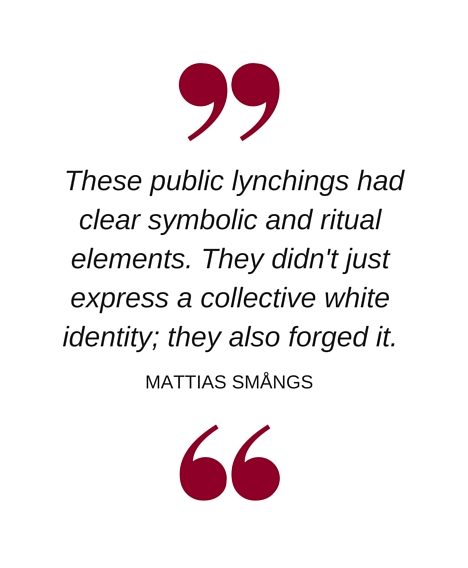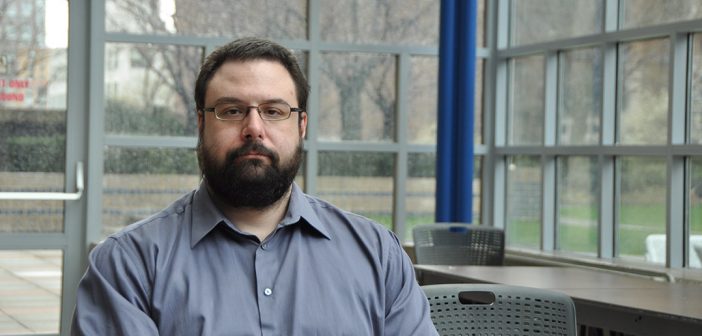Smångs, assistant professor of sociology and anthropology, studied hundreds of lynchings in the late 19th and early 20th centuries, focusing on those that were public and ritualistic. By defining white identity in terms of a threat that black people supposedly presented, these lynchings paved the way for repressive Jim Crow laws and, ultimately, for many inequities that are still with us, said Smångs.
In other words, lynching’s past is not fully past.
“It’s important to understand lynching, because it was not just an historical phenomenon. It has implications today,” said Smångs.
He took up this topic during graduate school at Columbia University after seeing that most sociologists treated lynchings as “undifferentiated” killings driven by economic competition between white and black people within the cotton-based economy of the South.
However, this view couldn’t account for the public spectacle and ceremonial violence, which would seem unnecessary if the killers were simply trying to eliminate someone seen as a troublesome employee or competitor, he said.
 Smångs’ study included more than 600 lynchings—mostly of African Americans—in Georgia and Louisiana from 1882 to 1930. He divided them into two types, private and public, depending on their level of communal participation and support as well as ceremonial brutality.
Smångs’ study included more than 600 lynchings—mostly of African Americans—in Georgia and Louisiana from 1882 to 1930. He divided them into two types, private and public, depending on their level of communal participation and support as well as ceremonial brutality.
Private lynchings were typically carried out furtively by small groups, usually to settle interpersonal conflicts, and were sometimes publicly criticized by Southern elites. “They saw it as unwarranted, as conflicting with their interests in having social order,” said Smångs.
Public lynchings, however, were another story.
Before 1890, racism in the South reflected paternalistic views—held over from slavery times—of African Americans as intellectually and morally inferior and needing guidance from whites. Southern white leaders sought to co-opt black elites to say, “‘As long as the federal government and the North stay out of our business, we will foster cooperative race relations—that view of ‘cooperative,’ of course, on whites’ terms,” Smångs said.
But views changed when African Americans refused to play a subordinate part. Around 1890 a long-simmering racial ideology that cast black people as inherently threatening and biologically inferior came to the fore, Smångs said. “It seems to be a watershed point when it comes to public lynchings,” which he defined as being carried out by mobs of 50 or more and including ritualistic and symbolic elements.
The public lynchings became more common and more elaborately brutal around this time, Smångs said. Victims were tortured, mutilated, burned, or collectively shot. Sometimes signs were left near the site of the lynching. Sometimes the victim was killed at the scene of the crime ascribed to him, or confronted first with those who suffered the crime.
Meanwhile, public rhetoric—from journalists, politicians, and others—was clearly meant to achieve “a cohesive white community” through public lynchings, Smångs said.
“They said it’s the duty of all men to come together and punish these crimes, alleged murders, and alleged sexual assaults,” he said. “In the aftermath of some lynchings, newspaper editors and journalists and other people would say that the people of such-and-such locality did their civic duty to the white community.”
“They saw it as a community affair, and as a responsibility of whites towards other whites to come together,” he said.
He lays out his arguments in “Doing Violence, Making Race: Southern Lynching and White Racial Group Formation,” published in the American Journal of Sociology in March. He is expanding the article into a book to be published by Routledge, and will be presenting his research this summer at the American Sociological Association annual meeting in Seattle.
Smångs is departing from the view that lynchings expressed a social system that was already established. Rather, public lynchings cemented views as much as they reflected them.
“It’s not only that belief creates ritual, but rituals create beliefs,” he said. “These public lynchings had clear symbolic and ritual elements. They didn’t just express a collective white identity; they also forged it.”
They also created “a stigmatized collective group identity for African Americans, which included these notions of danger and threat,” he said.
This stigma fomented the passage of Jim Crow laws that disenfranchised and segregated African Americans, as well as the laws’ longer-term injustices that other scholars have documented, Smångs said. These include black people’s disproportionate rate of being imprisoned and receiving death sentences, and also problems in the areas where lynchings took place–like interracial homicide and the presence of white supremacist organizations.
These problems reflect what the scholar Khalil Gibran Muhammad has called the “condemnation of blackness” as dangerous and unworthy, a perception that was given “force and legitimacy” under Jim Crow, Smångs said.
“The ideas about race that are prevalent today are, for the most part, not the ideas that sustained slavery; they are the ideas that came about with the extremist white supremacy of Jim Crow,” he said. “It’s important to understand lynching because it impacted Jim Crow, and the legacy of Jim Crow is still around today.”

